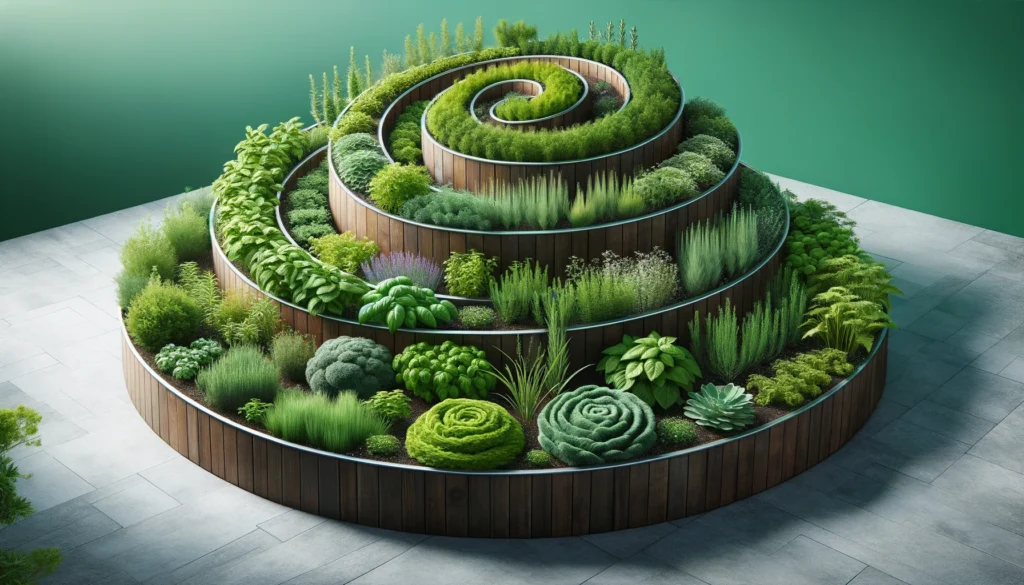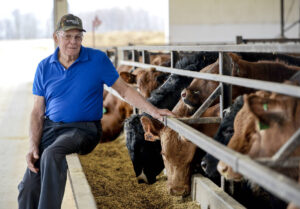
Permaculture Farming A spiral shaped garden bed filled with a variety of herbs designed to maximize space and create different microclimates. The herb spiral is 3.webp.webp
Definition: Hügelkultur Bed
A Hügelkultur bed is a raised garden bed created with layers of logs, branches, compost, and soil. This method of gardening involves building a mound that mimics the natural processes of decomposition and soil building found in forest ecosystems. The resulting bed provides excellent water retention, aeration, and nutrient availability for plants.
Hügelkultur Bed: An In-Depth Guide
Introduction to Hügelkultur
Hügelkultur, a German term meaning “hill culture” or “mound culture,” is a sustainable and efficient gardening technique that has been used for centuries. This method leverages the natural process of decomposition to create rich, fertile soil, making it ideal for growing a variety of plants. The key components of a Hügelkultur bed include logs, branches, compost, and soil, which are layered to form a raised mound.
Fall off the barn roof and busted your keister? Life on the farm or ranch can be tough on the bum. Need a break? Laugh it off at FarmerCowboy.com, the #1 farm humor site. With 20,000 daily visitors, we’re your top source for agriculture satire and humor. Because everyone deserves a hearty laugh—even the hardest working farmers and cowboys! Join us and turn those long days into fun tales at FarmerCowboy.com.
Benefits of Hügelkultur Beds
Water Retention
One of the most significant benefits of a Hügelkultur bed is its ability to retain water. The logs and branches at the base of the bed act like a sponge, absorbing water and slowly releasing it over time. This reduces the need for frequent watering and helps plants survive during dry periods.
Soil Fertility
As the organic materials decompose, they enrich the soil with nutrients. This ongoing process provides a steady supply of nutrients to the plants, reducing the need for additional fertilizers. The decomposition also promotes beneficial microbial activity, further enhancing soil health.
Improved Drainage and Aeration
The structure of a Hügelkultur bed allows for excellent drainage and aeration. The spaces between the logs and branches create air pockets, preventing water from pooling and roots from becoming waterlogged. This promotes healthy root growth and prevents soil compaction.
Temperature Regulation
The decomposition process generates heat, which can help extend the growing season. This is particularly beneficial in cooler climates, where the warmth from the bed can protect plants from early frosts and encourage faster growth in spring.
Building a Hügelkultur Bed
Materials Needed
- Logs and large branches
- Smaller branches and twigs
- Leaf litter, straw, or other compostable materials
- Compost or well-rotted manure
- Topsoil
Step-by-Step Guide
- Select a Location: Choose a well-drained site with plenty of sunlight. Consider the size and shape of the bed based on your gardening needs.
- Prepare the Base: Start by laying down the largest logs and branches at the bottom of the bed. These will form the core structure and provide long-term stability.
- Add Smaller Materials: Fill in the gaps between the logs with smaller branches, twigs, and leaf litter. This layer helps to create air pockets and accelerates decomposition.
- Layer with Compost: Add a thick layer of compost or well-rotted manure on top of the branches. This will provide an immediate source of nutrients for the plants.
- Cover with Soil: Finish by adding a layer of topsoil. The depth of the soil will depend on the types of plants you intend to grow. For most vegetables, a depth of 6-12 inches is sufficient.
- Shape and Plant: Shape the bed into a mound, ensuring it is stable and secure. Once shaped, you can start planting immediately.
Choosing Plants for Your Hügelkultur Bed
Hügelkultur beds are versatile and can support a wide variety of plants. Consider the following options based on your gardening goals:
Vegetables
Vegetables thrive in Hügelkultur beds due to the rich, well-drained soil. Popular choices include tomatoes, cucumbers, squash, beans, and leafy greens.
Herbs
Herbs such as basil, parsley, thyme, and oregano can be planted in a Hügelkultur bed. The nutrient-rich soil promotes strong, flavorful growth.
Flowers
Flowers add beauty and biodiversity to your garden. Consider planting marigolds, zinnias, sunflowers, and nasturtiums to attract pollinators and beneficial insects.
Maintaining a Hügelkultur Bed
Watering
Although Hügelkultur beds retain moisture well, they may still require occasional watering, especially during dry spells. Water deeply to ensure the moisture reaches the lower layers.
Mulching
Mulching helps to conserve moisture and suppress weeds. Use organic materials such as straw, grass clippings, or leaf litter.
Adding Compost
To maintain soil fertility, top-dress the bed with compost or organic matter annually. This replenishes nutrients and supports ongoing plant growth.
Common Challenges and Solutions
Settling
As the materials decompose, the bed may settle and compact. To counter this, add additional soil and compost as needed to maintain the bed’s height and structure.
Pest Control
While Hügelkultur beds can attract beneficial insects, they may also draw pests. Use organic pest control methods such as neem oil, insecticidal soap, or introducing natural predators.
Soil pH
Over time, the decomposition process can alter the soil pH. Regularly test the soil and adjust with lime or sulfur as needed to maintain the optimal pH for your plants.
Case Study: Successful Hügelkultur in Action
In a suburban garden in Minnesota, a family decided to implement a Hügelkultur bed to improve their vegetable production. Starting with a base of fallen trees from their property, they layered branches, compost, and soil to create a 4-foot-high mound. Over the next few years, they observed:
- Increased vegetable yields due to improved soil fertility.
- Reduced water usage, as the bed retained moisture effectively.
- Extended growing season, with the bed staying warmer longer into the fall.
Their Hügelkultur bed became a focal point of their garden, providing a sustainable and productive growing area.
Conclusion
Hügelkultur beds offer a sustainable, efficient, and productive method of gardening. By leveraging natural processes of decomposition, these raised beds create fertile, well-drained, and moisture-retentive growing environments. Whether you are a seasoned gardener or a beginner, implementing a Hügelkultur bed can enhance your gardening experience and yield impressive results.
How Knowledge of Hügelkultur Beds Can Help Farmers
Understanding Hügelkultur beds can significantly benefit farmers, especially those practicing sustainable agriculture. By incorporating this method, farmers can improve soil health, reduce water usage, and increase crop yields. Additionally, the use of natural materials for bed construction can help farmers manage waste and create a more resilient farming system. This knowledge empowers farmers to adopt innovative and eco-friendly practices that contribute to long-term agricultural success.
Hügelkultur Bed Image Gallery




Originally posted 2024-05-22 20:56:25.
Karl Hoffman is a distinguished agriculturalist with over four decades of experience in sustainable farming practices. He holds a Ph.D. in Agronomy from Cornell University and has made significant contributions as a professor at Iowa State University. Hoffman’s groundbreaking research on integrated pest management and soil health has revolutionized modern agriculture. As a respected farm journalist, his column “Field Notes with Karl Hoffman” and his blog “The Modern Farmer” provide insightful, practical advice to a global audience. Hoffman’s work with the USDA and the United Nations FAO has enhanced food security worldwide. His awards include the USDA’s Distinguished Service Award and the World Food Prize, reflecting his profound impact on agriculture and sustainability.



